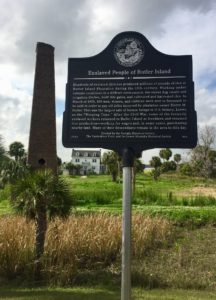Year Erected: 2019
 Marker Text: Hundreds of enslaved Africans produced millions of pounds of rice at Butler Island Plantation during the 19th century. Working under extreme conditions in a difficult environment, the slaves dug canals and irrigation ditches, built tide gates, and cultivated and harvested rice. In March of 1859, 436 men, women, and children were sent to Savannah to be sold in order to pay off debts incurred by plantation owner Pierce M. Butler. This was the largest sale of human beings in U.S. history, known as the “Weeping Time.” After the Civil War, some of the formerly enslaved workers returned to Butler Island as freedmen and resumed rice production—working for wages and, in some cases, purchasing nearby land. Many of their descendants remain in the area to this day.
Marker Text: Hundreds of enslaved Africans produced millions of pounds of rice at Butler Island Plantation during the 19th century. Working under extreme conditions in a difficult environment, the slaves dug canals and irrigation ditches, built tide gates, and cultivated and harvested rice. In March of 1859, 436 men, women, and children were sent to Savannah to be sold in order to pay off debts incurred by plantation owner Pierce M. Butler. This was the largest sale of human beings in U.S. history, known as the “Weeping Time.” After the Civil War, some of the formerly enslaved workers returned to Butler Island as freedmen and resumed rice production—working for wages and, in some cases, purchasing nearby land. Many of their descendants remain in the area to this day.
Erected by the Georgia Historical Society, The Vanderkloot Fund, and the Lower Altamaha Historical Society
